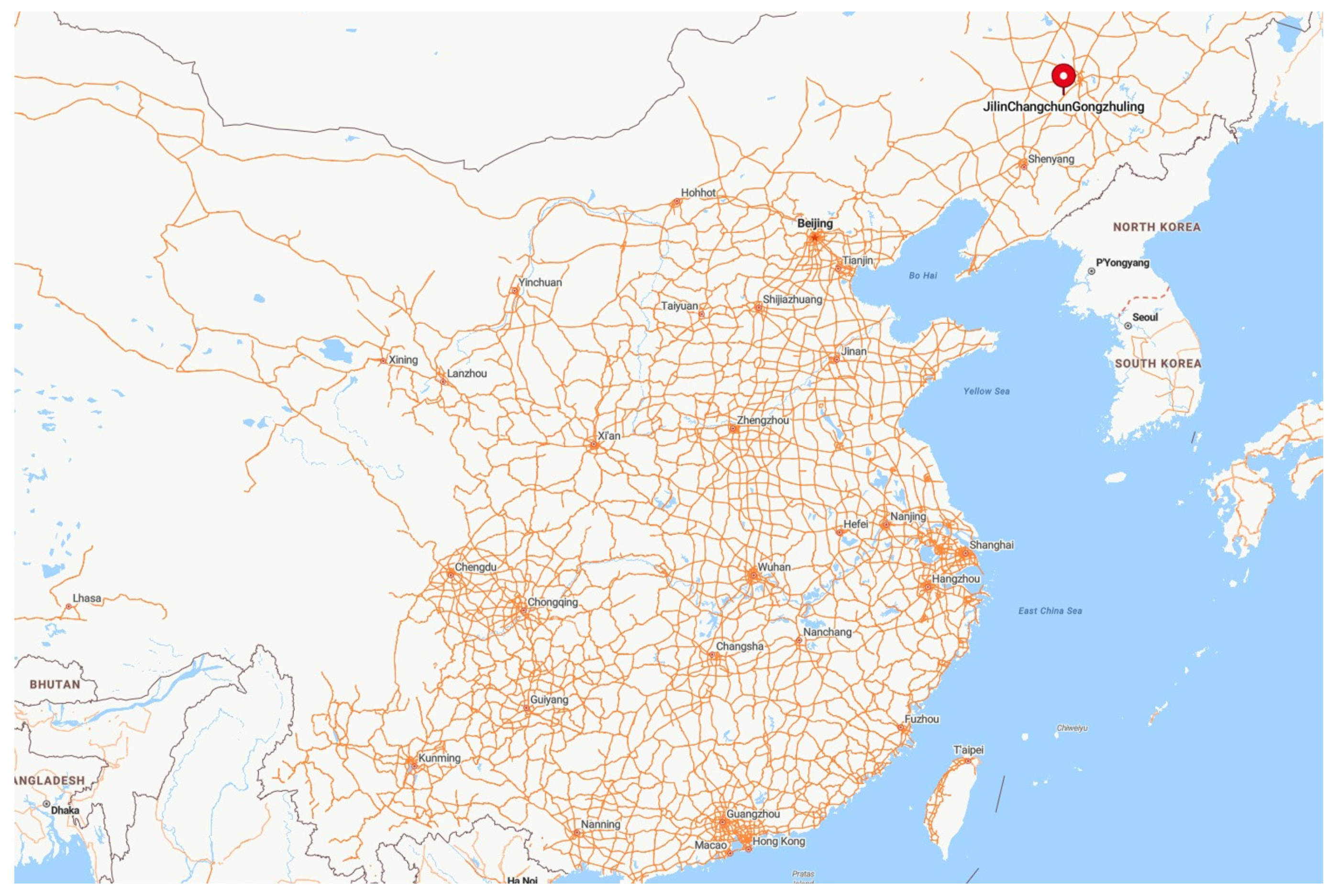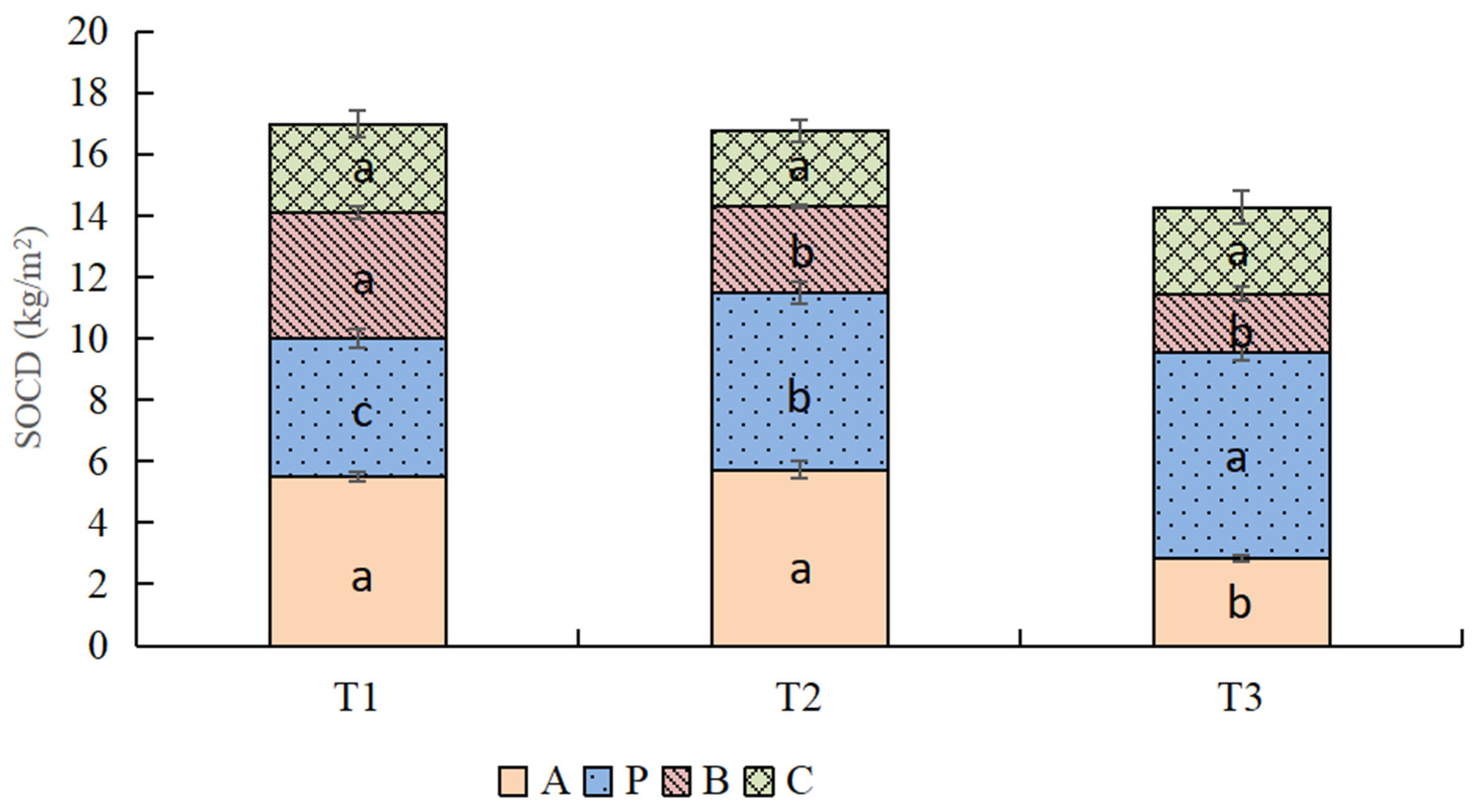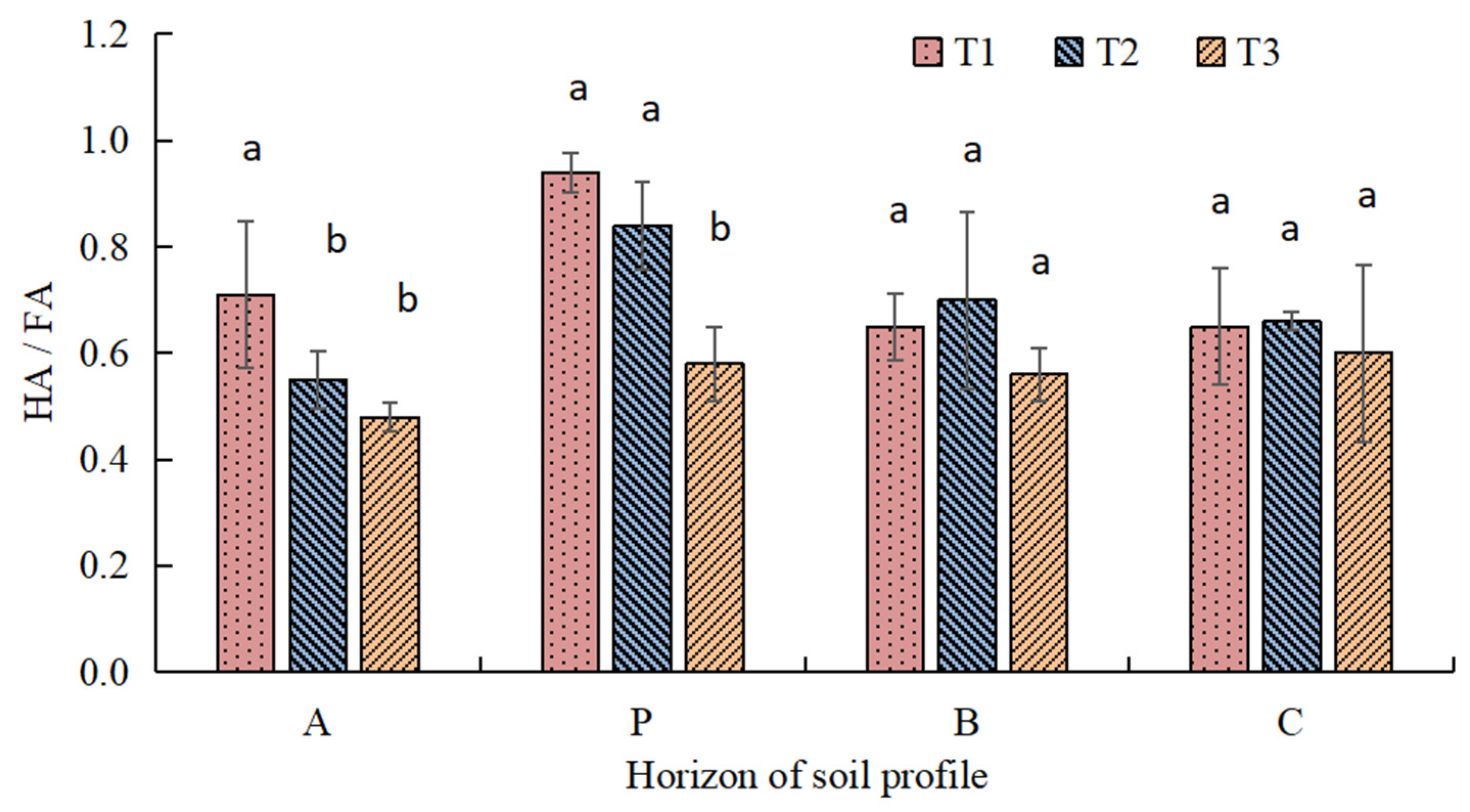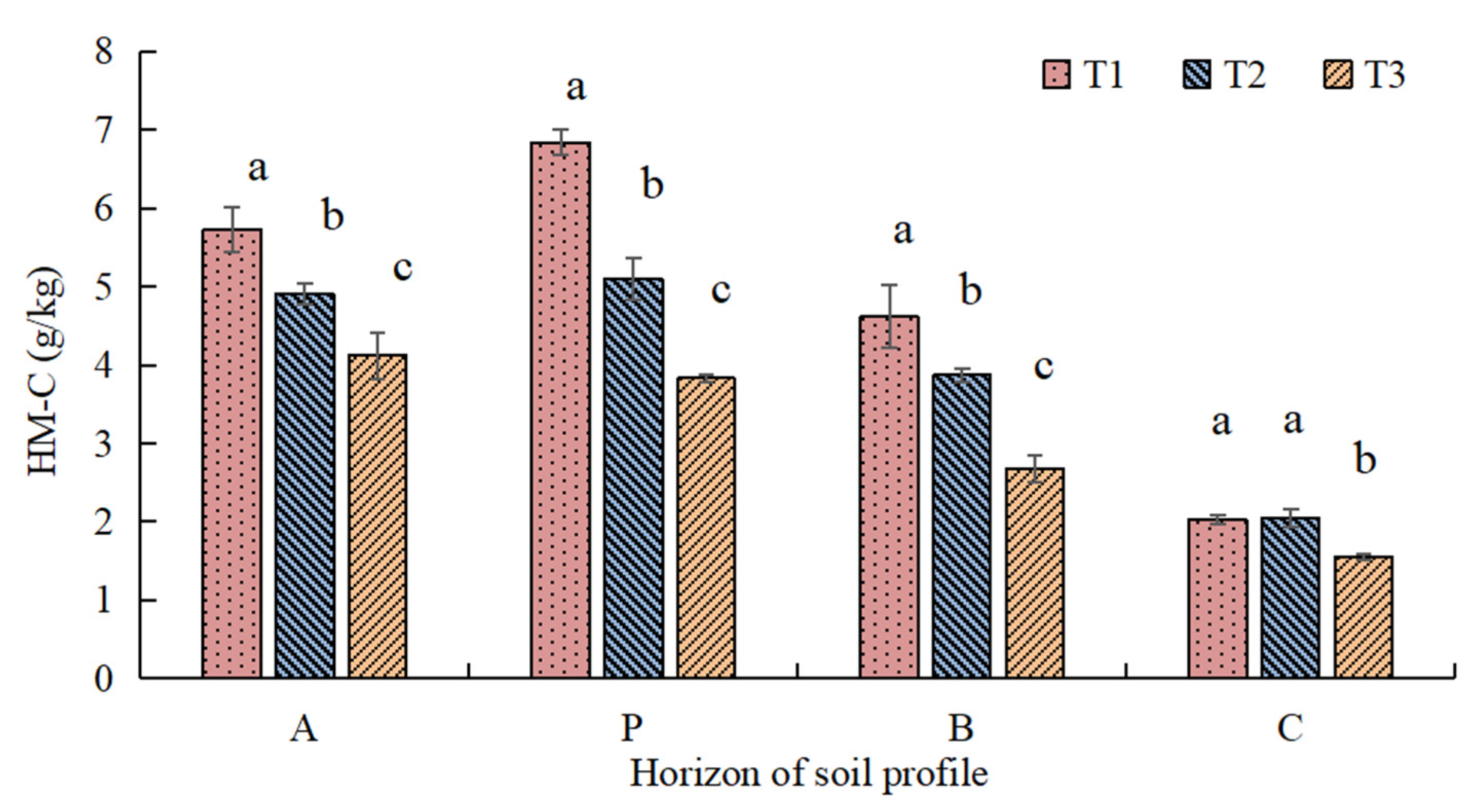Does the Biennial Straw Return Have an Identical Characteristic of Soil Organic Carbon Sequestration as the Annual? A Case Study of Cornfield in Northeast China
Abstract
1. Introduction
2. Materials and Methods
3. Results
3.1. The Distribution Characteristics of SOC
3.2. The Distribution Characteristics of SOCD
3.3. The Composition and Characteristics of HE-C
3.4. The Distribution Characteristics of HM-C
3.5. Proportion of Straw Carbon Converted to SOC
4. Discussion
5. Conclusions
Author Contributions
Funding
Data Availability Statement
Conflicts of Interest
Appendix A
| Soil Horizon | Treatments | ||
|---|---|---|---|
| T1 | T2 | T3 | |
| A | 1.35 ± 0.06 b | 1.46 ± 0.04 ab | 1.59 ± 0.03 a |
| P | 1.51 ± 0.05 b | 1.52 ± 0.07 b | 1.81 ± 0.03 a |
| B | 1.59 ± 0.06 a | 1.59 ± 0.05 a | 1.68 ± 0.04 a |
| C | 1.55 ± 0.08 b | 1.63 ± 0.05 ab | 1.79 ± 0.07 a |
References
- Li, Y.; Chen, H.; Feng, H.; Dong, Q.; Wu, W.; Zou, Y.; Chau, H.W.; Siddique, K.H. Influence of straw incorporation on soil water utilization and summer maize productivity: A five-year field study on the Loess Plateau of China. Agric. Water Manag. 2020, 233, 106106. [Google Scholar] [CrossRef]
- Qin, X.L.; Huang, T.T.; Lu, C.; Dang, P.; Zhang, M.; Guan, X.-K.; Wen, P.-F.; Wang, T.-C.; Chen, Y.; Siddique, K.H. Benefits and limitations of straw mulching and incorporation on maize yield, water use efficiency, and nitrogen use efficiency. Agric. Water Manag. 2021, 256, 107128. [Google Scholar] [CrossRef]
- Mo, F.; Yang, D.Y.; Wang, X.K.; Crowther, T.W.; Vinay, N.; Luo, Z.; Yu, K.; Sun, S.; Zhang, F.; Xiong, Y.; et al. Nutrient limitation of soil organic carbon stocks under straw return. Soil Biol. Biochem. 2024, 192, 109360. [Google Scholar] [CrossRef]
- Zhu, C.C.; Zhong, W.H.; Han, C.; Deng, H.; Jiang, Y. Driving factors of soil organic carbon sequestration under straw returning across China’s uplands. J. Environ. Manag. 2023, 335, 117590. [Google Scholar] [CrossRef]
- Liu, X.Q.; Liu, H.R.; Zhang, Y.S.; Chen, G.; Li, Z.; Zhang, M. Straw return drives soil microbial community assemblage to change metabolic processes for soil quality amendment in a rice-wheat rotation system. Soil Biol. Biochem. 2023, 185, 109131. [Google Scholar] [CrossRef]
- Yan, S.S.; Song, J.M.; Fan, J.S.; Yan, C.; Dong, S.; Ma, C.; Gong, Z. Changes in soil organic carbon fractions and microbial community under rice straw return in Northeast China. Glob. Ecol. Conserv. 2020, 22, e00962. [Google Scholar] [CrossRef]
- Wang, S.C.; Lu, C.G.; Huai, S.C.; Yan, Z.; Wang, J.; Sun, J.; Raza, S. Straw burial depth and manure application affect the straw-C and N sequestration: Evidence from 13C & 15N-tracing. Soil Tillage Res. 2021, 208, 104884. [Google Scholar] [CrossRef]
- Huang, T.T.; Yang, N.; Lu, C.; Qin, X.; Siddique, K.H. Soil organic carbon, total nitrogen, available nutrients, and yield under different straw returning methods. Soil Tillage Res. 2021, 214, 105171. [Google Scholar] [CrossRef]
- Song, F.; Liu, M.; Zhang, Z.X.; Qi, Z.; Li, T.; Du, S.; Li, A.; Liu, J. No-tillage with straw mulching increased maize yield and nitrogen fertilizer recovery rate in northeast China. Agric. Water Manag. 2024, 292, 108687. [Google Scholar] [CrossRef]
- Bradford, M.A.; Berg, B.; Maynard, D.S.; Wieder, W.R.; Wood, S.A. Understanding the dominant controls on litter decomposition. J. Ecol. 2016, 104, 229–238. [Google Scholar] [CrossRef]
- Li, H.; Dai, M.W.; Dai, S.L.; Dong, X. Current status and environment impact of direct straw return in China’s cropland—A review. Ecotoxicol. Environ. Saf. 2018, 159, 293–300. [Google Scholar] [CrossRef]
- Xu, J.; Han, H.F.; Ning, T.Y.; Li, Z.; Lal, R. Long-term effects of tillage and straw management on soil organic carbon, crop yield, and yield stability in a wheat-maize system. Field Crop. Res. 2019, 233, 33–40. [Google Scholar] [CrossRef]
- Yang, H.S.; Fang, C.; Meng, Y.; Dai, Y.; Liu, J. Long-term ditch-buried straw return increases functionality of soil microbial communities. Catena 2021, 202, 105316. [Google Scholar] [CrossRef]
- Tang, H.; Wang, D.; Zhao, J.L.; Xu, C.; Wang, J. Mode and experiments of a straw ditch-burying returning and maturing in cold region of Northeast China. Eur. J. Agron. 2023, 151, 127006. [Google Scholar] [CrossRef]
- Wu, G.; Ling, J.; Zhao, D.Q.; Xu, Y.-P.; Liu, Z.-X.; Wen, Y.; Zhou, S.-L. Deep-injected straw incorporation improves subsoil fertility and crop productivity in a wheat-maize rotation system in the North China Plain. Field Crop. Res. 2022, 286, 108612. [Google Scholar] [CrossRef]
- Liu, W.M.; Liu, Y.E.; Liu, G.Z.; Xie, R.; Ming, B.; Yang, Y.; Guo, X.; Wang, K.; Xue, J.; Wang, Y.; et al. Estimation of maize straw production and appropriate straw return rate in China. Agric. Ecosyst. Environ. 2022, 328, 107865. [Google Scholar] [CrossRef]
- Zhang, X.; Sun, N.; Wu, L.; Xu, M.; Bingham, I.J.; Li, Z. Effects of enhancing soil organic carbon sequestration in the topsoil by fertilization on crop productivity and stability: Evidence from long-term experiments with wheat-maize cropping systems in China. Sci. Total Environ. 2016, 562, 247–259. [Google Scholar] [CrossRef]
- Islam, M.U.; Jiang, F.H.; Guo, Z.C.; Liu, S.; Peng, X. Impacts of straw return coupled with tillage practices on soil organic carbon stock in upland wheat and maize croplands in China: A meta-analysis. Soil Tillage Res. 2023, 232, 105786. [Google Scholar] [CrossRef]
- Qin, Z.C.; Huang, Y.; Zhuang, Q.L. Soil organic carbon sequestration potential of cropland in China. Glob. Biogeochem. Cycles 2013, 27, 711–722. [Google Scholar] [CrossRef]
- Zhang, Y.; Li, X.J.; Gregorich, E.G.; McLaughlin, N.B.; Zhang, X.; Guo, Y.; Liang, A.; Fan, R.; Sun, B. No-tillage with continuous maize cropping enhances soil aggregation and organic carbon storage in Northeast China. Geoderman Int. J. Soil Sci. 2018, 330, 204–211. [Google Scholar] [CrossRef]
- Du, S.; Gao, X.Z. Soil Analysis Technical Specifications, 1st ed.; Agriculture Press: Beijing, China, 2006; pp. 145–152. [Google Scholar]
- Yu, H.Y.; Zha, T.G.; Zhang, X.X.; Ma, L. Vertical distribution and influencing factors of soil organic carbon in the Loess Plateau, China. Sci. Total Environ. 2019, 693, 133632. [Google Scholar] [CrossRef] [PubMed]
- Lu, R.K. Methods for Agricultural Chemical Analysis of Soils; Agricultural Science and Technology Press: Beijing, China, 1999; pp. 234–236. [Google Scholar]
- Wang, H.; Wang, S.L.; Zhang, Y.J.; Wang, X.; Wang, R.; Li, J. Tillage system change affects soil organic carbon storage and benefits land restoration on loess soil in North China. Land Degrad. Dev. 2018, 29, 2880–2887. [Google Scholar] [CrossRef]
- Feng, Q.; An, C.J.; Chen, Z.; Wang, Z. Can deep tillage enhance carbon sequestration in soils? A meta-analysis towards GHG mitigation and sustainable agricultural management. Renew. Sustain. Energy Rev. 2020, 133, 110293. [Google Scholar] [CrossRef]
- Chen, J.; Pang, D.W.; Jin, M.; Luo, Y.-L.; Li, H.-Y.; Li, Y.; Wang, Z.-L. Improved soil characteristics in the deeper plough layer can increase grain yield of winter wheat. J. Integr. Agric. 2020, 19, 1215–1226. [Google Scholar] [CrossRef]
- Wang, Y.L.; Wu, P.N.; Mei, F.J.; Ling, Y.; Qiao, Y.; Liu, C.; Leghari, S.J.; Guan, X.; Wang, T. Does continuous straw returning keep China farmland soil organic carbon continued increase? A meta-analysis. J. Environ. Manag. 2021, 288, 112391. [Google Scholar] [CrossRef]
- Cai, A.D.; Liang, G.P.; Zhang, X.B.; Zhang, W.; Li, L.; Rui, Y.; Xu, M.; Luo, Y. Long-term straw decomposition in agro-ecosystems described by a unified three-exponentiation equation with thermal time. Sci. Total Environ. 2018, 636, 699–708. [Google Scholar] [CrossRef] [PubMed]
- Li, Y.M.; Dua, Y.; Wang, G.L.; Wang, A.-Q.; Shao, G.-Z.; Meng, X.-H.; Hu, H.-Y.; Zhang, D.-M. Straw alters the soil organic carbon composition and microbial community under different tillage practices in a meadow soil in Northeast China. Soil Tillage Res. 2021, 208, 104879. [Google Scholar] [CrossRef]
- Mu, X.Y.; Zhao, Y.L.; Liu, K.; Ji, B.; Guo, H.; Xue, Z.; Li, C. Responses of soil properties, root growth and crop yield to tillage and crop residue management in a wheat-maize cropping system on the North China Plain. Eur. J. Agron. 2016, 78, 32–43. [Google Scholar] [CrossRef]
- Wang, X.Y.; Xu, X.P.; Qiu, S.J.; Zhao, S.; He, P. Deep tillage enhanced soil organic carbon sequestration in China: A meta-analysis. J. Clean. Prod. 2023, 399, 136686. [Google Scholar] [CrossRef]
- Huo, L.; Pang, H.C.; Zhao, Y.G.; Wang, J.; Lu, C.; Li, Y. Buried straw layer plus plastic mulching improves soil organic carbon fractions in an arid saline soil from Northwest China. Soil Tillage Res. 2017, 165, 286–293. [Google Scholar] [CrossRef]
- Hobley, E.U.; Wilson, B.R. The depth distribution of organic carbon in the soils of eastern Australia. Ecosphere 2016, 7, e01214. [Google Scholar] [CrossRef]
- Kan, Z.R.; Liu, W.X.; Liu, W.S.; Lal, R.; Dang, Y.P.; Zhao, X.; Zhang, H. Mechanisms of soil organic carbon stability and its response to no-till: A global synthesis and perspective. Glob. Chang. Biol. 2022, 28, 693–710. [Google Scholar] [CrossRef] [PubMed]
- Han, Y.; Yao, S.H.; Jiang, H.; Ge, X.-L.; Zhang, Y.; Mao, J.; Dou, S.; Zhang, B. Effects of mixing maize straw with soil and placement depths on decomposition rates and products at two cold sites in the mollisol region of China. Soil Tillage Res. 2020, 197, 104519. [Google Scholar] [CrossRef]
- He, P.; Li, L.J.; Dai, S.S.; Guo, X.-L.; Nie, M.; Yang, X.; Kuzyakov, Y. Straw addition and low soil moisture decreased temperature sensitivity and activation energy of soil organic matter. Geoderma 2024, 442, 116802. [Google Scholar] [CrossRef]
- Pang, D.; Chen, J.; Jin, M.; Li, H.; Luo, Y.; Li, W.; Chang, Y.; Wang, Z. Changes in soil micro- and macro-aggregate associated carbon storage following straw incor-poration. Catena 2020, 190, 104555. [Google Scholar] [CrossRef]
- Li, Y.S.; Xie, Z.H.; Yu, Z.H.; Wang, Y.; Liu, C.; Wang, G.; Wu, J.; Jin, J.; Liu, X. Impact of surface soil manuring on particulate carbon fractions in relevant to nutrient stoi-chiometry in a Mollisolprofile. Soil Tillage Res. 2021, 207, 104859. [Google Scholar] [CrossRef]
- Dou, S.; Shan, J.; Song, X.Y.; Cao, R.; Wu, M.; Li, C.; Guan, S. Are humic substances soil microbial residues or unique synthesized compounds? A perspective on their distinctiveness. Pedosphere 2020, 30, 159–167. [Google Scholar] [CrossRef]
- Kukuls, I.; Klavinš, M.; Nikodemus, O.; Kasparinskis, R.; Brūmelis, G. Changes in soil organic matter and soil humic substances following the afforestation of former agricultural lands in the boreal-nemoral ecotone (Latvia). Geoderma Reg. 2019, 16, e00213. [Google Scholar] [CrossRef]
- Olk, D.C.; Bloom, P.R.; Perdue, E.M.; McKnight, D.M.; Chen, Y.; Farenhorst, A.; Senesi, N.; Chin, Y.-P.; Schmitt-Kopplin, P.; Hertkorn, N.; et al. Environmental and agricultural relevance of humic fractions extracted by alkali from soils and natural waters. J. Environ. Q. 2019, 48, 217–232. [Google Scholar] [CrossRef]
- Ni, H.; Liu, C.; Sun, B.; Liang, Y. Response of global farmland soil organic carbon to nitrogen application over time depends on soil type. Geoderma 2022, 406, 115542. [Google Scholar] [CrossRef]
- Hayes, M.H.B.; Swift, R.S. An appreciation of the contribution of Frank Stevenson to the advancement of studies of soil organic matter and humic substances. J. Soils Sedim. 2018, 18, 1212–1231. [Google Scholar] [CrossRef]
- Cui, T.T.; Li, Z.H.; Wang, S.J. Effects of in-situ straw decomposition on composition of humus and structure of humic acid at different soil depths. J. Soils Sedim. 2017, 17, 2391–2399. [Google Scholar] [CrossRef]
- Dębska, B.; Długosz, J.; Piotrowska-Długosz, A.; Banach-Szott, M. The impact of a bio-fertilizer on the soil organic matter status and carbon sequestration-Results from a field-scale study. J. Soils Sedim. 2016, 16, 2335–2343. [Google Scholar] [CrossRef]
- Zhang, J.J.; Hu, F.; Li, H.X.; Gao, Q.; Song, X.; Ke, X.; Wang, L. Effects of earthworm activity on humus composition and humus composition and humic acid characteristics of soil in a maize residue amended rice-wheat rotation agroecosystem. Appl. Soil Ecol. 2011, 51, 1–8. [Google Scholar] [CrossRef]
- Rivero, C.; Chirenje, T.; Ma, L.Q.; Martinez, G. Influence of compost on soil organic matter quality under tropical conditions. Geodermav 2004, 123, 355–361. [Google Scholar] [CrossRef]
- Zhao, X.M.; He, L.; Zhang, Z.D.; Wang, H.B.; Zhao, L.P. Simulation of accumulation and mineralization (CO2 release) of organic carbon in cher-nozem under different straw return ways after corn harvesting. Soil Tillage Res. 2016, 156, 148–154. [Google Scholar] [CrossRef]
- Stewart, C.E.; Plante, A.F.; Paustian, K.; Conant, R.T.; Six, J. Soil carbon saturation: Linking concept and measurable carbon pools. Soil Sci. Soc. Am. J. 2007, 72, 379–392. [Google Scholar] [CrossRef]
- Lu, T.P.; Wang, X.J.; Du, Z.L.; Wu, L. Impacts of continuous biochar application on major carbon fractions in soil profile of North China Plain’s cropland: In comparison with straw incorporation. Agric. Ecosyst. Environ. 2021, 315, 107445. [Google Scholar] [CrossRef]
- Wang, J.Z.; Wang, X.J.; Xu, M.G.; Feng, G.; Zhang, W.; Yang, X.; Huang, S. Contributions of wheat and maize residues to soil organic carbon under long-term rotation in north China. Sci. Rep. 2015, 5, 11409. [Google Scholar] [CrossRef]







| Treatments | Total Straw Returning (kg/hm2) | Total Straw-C Returning (kg/hm2) * | SOCD in Soil Profile of 0–100 cm (kg/m2) | SOCD Increased (kg/m2) | Conversion Rate from Straw Carbon to SOC (%) |
|---|---|---|---|---|---|
| T1 | 38,000 | 15,200 | 16.90 | 0.28 | 18.42 |
| T2 | 19,000 | 7600 | 16.78 | 0.16 | 21.05 |
| T3 | 0 | 0 | 16.62 |
Disclaimer/Publisher’s Note: The statements, opinions and data contained in all publications are solely those of the individual author(s) and contributor(s) and not of MDPI and/or the editor(s). MDPI and/or the editor(s) disclaim responsibility for any injury to people or property resulting from any ideas, methods, instructions or products referred to in the content. |
© 2024 by the authors. Licensee MDPI, Basel, Switzerland. This article is an open access article distributed under the terms and conditions of the Creative Commons Attribution (CC BY) license (https://creativecommons.org/licenses/by/4.0/).
Share and Cite
Liu, J.; Zhao, X.; Zhang, Z.; Zhao, C.; Huang, N.; Wang, H. Does the Biennial Straw Return Have an Identical Characteristic of Soil Organic Carbon Sequestration as the Annual? A Case Study of Cornfield in Northeast China. Agronomy 2024, 14, 1174. https://doi.org/10.3390/agronomy14061174
Liu J, Zhao X, Zhang Z, Zhao C, Huang N, Wang H. Does the Biennial Straw Return Have an Identical Characteristic of Soil Organic Carbon Sequestration as the Annual? A Case Study of Cornfield in Northeast China. Agronomy. 2024; 14(6):1174. https://doi.org/10.3390/agronomy14061174
Chicago/Turabian StyleLiu, Jinhua, Xingmin Zhao, Zhongqing Zhang, Chenyu Zhao, Ning Huang, and Hongbin Wang. 2024. "Does the Biennial Straw Return Have an Identical Characteristic of Soil Organic Carbon Sequestration as the Annual? A Case Study of Cornfield in Northeast China" Agronomy 14, no. 6: 1174. https://doi.org/10.3390/agronomy14061174
APA StyleLiu, J., Zhao, X., Zhang, Z., Zhao, C., Huang, N., & Wang, H. (2024). Does the Biennial Straw Return Have an Identical Characteristic of Soil Organic Carbon Sequestration as the Annual? A Case Study of Cornfield in Northeast China. Agronomy, 14(6), 1174. https://doi.org/10.3390/agronomy14061174





